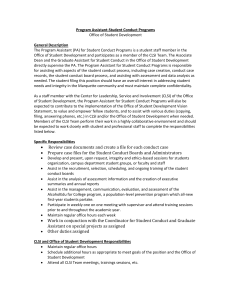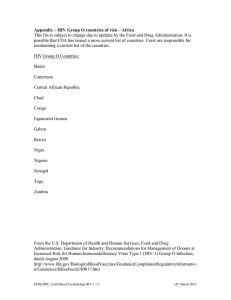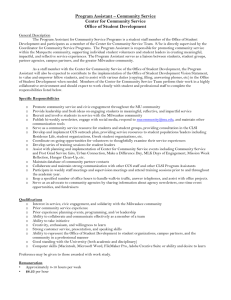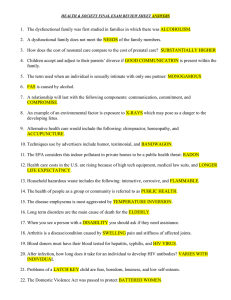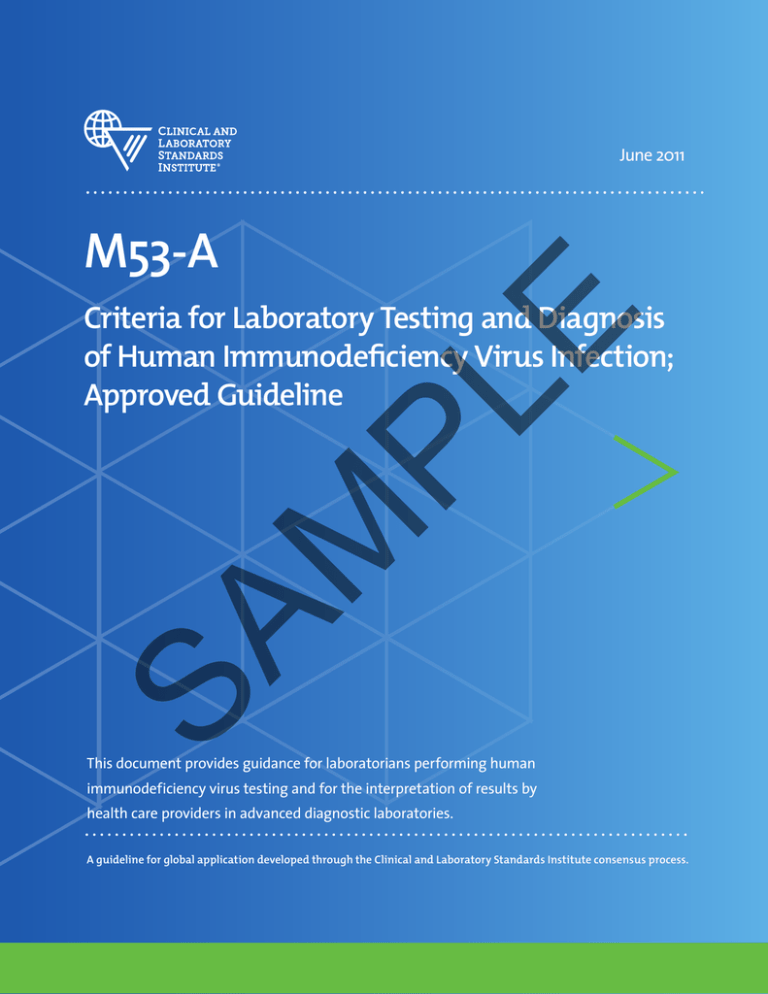
June 2011
M53-A
SA
M
PL
E
Criteria for Laboratory Testing and Diagnosis
of Human Immunodeficiency Virus Infection;
Approved Guideline
This document provides guidance for laboratorians performing human
immunodeficiency virus testing and for the interpretation of results by
health care providers in advanced diagnostic laboratories.
A guideline for global application developed through the Clinical and Laboratory Standards Institute consensus process.
Clinical and Laboratory Standards Institute
Setting the standard for quality in clinical laboratory testing around the world.
The Clinical and Laboratory Standards Institute (CLSI) is a not-for-profit membership organization that brings
together the varied perspectives and expertise of the worldwide laboratory community for the advancement of
a common cause: to foster excellence in laboratory medicine by developing and implementing clinical laboratory
standards and guidelines that help laboratories fulfill their responsibilities with efficiency, effectiveness, and
global applicability.
Consensus Process
E
Consensus—the substantial agreement by materially affected, competent, and interested parties—is core to the
development of all CLSI documents. It does not always connote unanimous agreement, but does mean that the
participants in the development of a consensus document have considered and resolved all relevant objections
and accept the resulting agreement.
Commenting on Documents
PL
CLSI documents undergo periodic evaluation and modification to keep pace with advancements in technologies,
procedures, methods, and protocols affecting the laboratory or health care.
CLSI’s consensus process depends on experts who volunteer to serve as contributing authors and/or as
participants in the reviewing and commenting process. At the end of each comment period, the committee that
developed the document is obligated to review all comments, respond in writing to all substantive comments,
and revise the draft document as appropriate.
Appeals Process
M
Comments on published CLSI documents are equally essential, and may be submitted by anyone, at any time, on
any document. All comments are addressed according to the consensus process by a committee of experts.
SA
If it is believed that an objection has not been adequately addressed, the process for appeals is documented in
the CLSI Standards Development Policies and Process document.
All comments and responses submitted on draft and published documents are retained on file at CLSI and are
available upon request.
Get Involved—Volunteer!
Do you use CLSI documents in your workplace? Do you see room for improvement? Would you like to get
involved in the revision process? Or maybe you see a need to develop a new document for an emerging
technology? CLSI wants to hear from you. We are always looking for volunteers. By donating your time and
talents to improve the standards that affect your own work, you will play an active role in improving public
health across the globe.
For further information on committee participation or to submit comments, contact CLSI.
Clinical and Laboratory Standards Institute
950 West Valley Road, Suite 2500
Wayne, PA 19087 USA
P: 610.688.0100
F: 610.688.0700
www.clsi.org
standard@clsi.org
M53-A
Vol. 31 No. 13
Replaces M53-P
Vol. 30 No. 21
ISBN 1-56238-757-X (Print)
ISBN 1-56238-758-8 (Electronic)
ISSN 0273-3099
Criteria for Laboratory Testing and Diagnosis of Human
Immunodeficiency Virus Infection; Approved Guideline
M
Abstract
PL
Eric S. Rosenberg, MD
Catherine A. Brennan, PhD
Christiane Claessens, MSc
Niel T. Constantine, PhD
Gary Murphy, PhD
S. Michele Owen, PhD
Barbara G. Werner, PhD
Joseph D.C. Yao, MD
Belinda Yen-Lieberman, PhD
Bernard M. Branson, MD
Patricia E. Garrett, PhD
Renée M. Howell, PhD
E
Volume 31 Number 13
SA
The accurate diagnosis of human immunodeficiency virus (HIV) infection is essential for limiting the spread of infection and for
the appropriate clinical management of persons infected with HIV. Over the past several years, numerous tests and testing
strategies have been developed and are used by laboratorians and clinicians to diagnose HIV infection. CLSI document M53-A,
Criteria for Laboratory Testing and Diagnosis of Human Immunodeficiency Virus Infection; Approved Guideline, provides an
extensive review of existing laboratory methods commonly used to test for HIV infection. This guideline also offers
recommendations for how to best use and interpret these tests accurately and effectively to diagnose HIV infection.
Clinical and Laboratory Standards Institute (CLSI). Criteria for Laboratory Testing and Diagnosis of Human Immunodeficiency
Virus Infection; Approved Guideline. CLSI document M53-A (ISBN 1-56238-757-X [Print]; ISBN 1-56238-758-8 [Electronic]).
Clinical and Laboratory Standards Institute, 950 West Valley Road, Suite 2500, Wayne, Pennsylvania 19087 USA, 2011.
The Clinical and Laboratory Standards Institute consensus process, which is the mechanism for moving a document through
two or more levels of review by the health care community, is an ongoing process. Users should expect revised editions of any
given document. Because rapid changes in technology may affect the procedures, methods, and protocols in a standard or
guideline, users should replace outdated editions with the current editions of CLSI documents. Current editions are listed in
the CLSI catalog and posted on our website at www.clsi.org. If your organization is not a member and would like to become
one, and to request a copy of the catalog, contact us at: Telephone: 610.688.0100; Fax: 610.688.0700; E-Mail:
customerservice@clsi.org; Website: www.clsi.org.
Number 13
M53-A
Copyright ©2011 Clinical and Laboratory Standards Institute. Except as stated below, any reproduction of
content from a CLSI copyrighted standard, guideline, companion product, or other material requires
express written consent from CLSI. All rights reserved. Interested parties may send permission requests to
permissions@clsi.org.
E
CLSI hereby grants permission to each individual member or purchaser to make a single reproduction of
this publication for use in its laboratory procedure manual at a single site. To request permission to use
this publication in any other manner, e-mail permissions@clsi.org.
Suggested Citation
Proposed Guideline
October 2010
Approved Guideline
SA
M
June 2011
PL
CLSI. Criteria for Laboratory Testing and Diagnosis of Human Immunodeficiency Virus Infection;
Approved Guideline. CLSI document M53-A. Wayne, PA: Clinical and Laboratory Standards Institute;
2011.
ISBN 1-56238-757-X (Print)
ISBN 1-56238-758-8 (Electronic)
ISSN 0273-3099
ii
Volume 31
M53-A
Contents
Abstract ....................................................................................................................................................i Committee Membership........................................................................................................................ iii Foreword .............................................................................................................................................. vii 1 Scope .......................................................................................................................................... 1 2 Standard Precautions.................................................................................................................. 1 3 Terminology............................................................................................................................... 1 Background/Natural History/Virology ...................................................................................... 6 5 Initial Tests for HIV Infection ................................................................................................. 10 5.1 5.2 5.3 5.4 5.5 5.6 5.7 6 The Human Immunodeficiency Virus .......................................................................... 6 Natural History and Response to Infection ................................................................... 8 PL
4.1 4.2 Introduction ................................................................................................................. 10 Types of Initial Testing for HIV ................................................................................. 11 Viral Detection Tests for Initial Testing ..................................................................... 16 Selection of Initial Tests ............................................................................................. 17 Limitations of Initial Tests .......................................................................................... 18 Borderline Test Results ............................................................................................... 18 Commercially Available Initial Tests ......................................................................... 18 M
4 A Note on Terminology ................................................................................................ 1 Definitions .................................................................................................................... 2 Abbreviations and Acronyms ....................................................................................... 5 E
3.1 3.2 3.3 Supplemental HIV Tests .......................................................................................................... 18 Western Blot ............................................................................................................... 18 Line Immunoassays .................................................................................................... 22 Indirect Immunofluorescence Assay........................................................................... 24 Nucleic Acid Tests ...................................................................................................... 26 Enzyme Immunoassay ................................................................................................ 30 SA
6.1 6.2 6.3 6.4 6.5 7 Special Situations ..................................................................................................................... 31 7.1 7.2 7.3 7.4 7.5 7.6 7.7 7.8 7.9 8 Acute HIV-1 Infections .............................................................................................. 31 HIV-1, Non-B, and HIV-2 Infection........................................................................... 33 HIV-1/HIV-2 Initial and Supplemental Testing in Pregnancy ................................... 38 Testing During Labor and Delivery, and Newborn Testing ....................................... 39 HIV-1 Seroreversion or Incomplete Anti-HIV-1 Antibody Evolution ....................... 39 Recent Infection .......................................................................................................... 40 Serological Testing in HIV Vaccine Trial Participants .............................................. 43 Special Situations on Blood and Body Fluid Exposures............................................. 43 Home Testing .............................................................................................................. 44 Algorithms ............................................................................................................................... 44 8.1 8.2 Algorithm I: Single Initial Antigen/Antibody Combination Immunoassay ................ 45 Algorithm II: HIV-1/HIV-2 Antibody Immunoassay With HIV-1 Supplemental
Tests ............................................................................................................................ 47 v
Number 13
M53-A
Contents (Continued)
8.3 8.4 8.5 8.6 8.7 Test Results and Reporting ...................................................................................................... 57 10 Initial Tests .................................................................................................................57 Supplemental Tests ..................................................................................................... 58 Notification of Significant Test Results ...................................................................... 59 Requirements for Specimen Retention ....................................................................... 60 E
9.1 9.2 9.3 9.4 HIV Testing Quality Control ................................................................................................... 60 10.1 10.2 10.3 10.4 Establishing a Quality Control Program ..................................................................... 60 Types of Control Materials ......................................................................................... 66 Sources of Control Material ........................................................................................ 67 Proficiency Testing Programs ..................................................................................... 67 PL
9 Algorithm III: Sequential HIV Antibody Immunoassay for Presumptive
Diagnosis .................................................................................................................... 49 Algorithm IV: Sequential HIV Antibody Immunoassays With Initial Oral Fluid
Specimen ..................................................................................................................... 51 Algorithm V: Initial HIV Antigen/Antibody Discriminatory Immunoassay .............. 53 Algorithm VI: Acute HIV Infection Testing............................................................... 55 Resolution of Inconclusive or Persistently Indeterminate Results.............................. 57 References ............................................................................................................................................. 68 Appendix. Reporting Comments Suggested for Initial and Supplemental HIV Diagnostic Test
Results ................................................................................................................................................. 79 M
The Quality Management System Approach ........................................................................................ 88 SA
Related CLSI Reference Materials ....................................................................................................... 89 vi
Volume 31
M53-A
Foreword
Since the advent of human immunodeficiency virus (HIV) testing, laboratory-based methods have
undergone tremendous change. The routine use of nucleic acid tests, the introduction of antigen-antibody
combination tests, and the widespread implementation of rapid testing methods, including the use of
different specimen types, have changed the way HIV infection is diagnosed. Although these tests may
offer improved sensitivity, specificity, and more rapid turnaround times, clinicians and laboratorians are
asked to determine which tests to perform and how to best interpret the results.
E
There is increasing momentum to establish universal routine testing programs for HIV infection in order
to limit the spread of infection and to identify individuals who may benefit from earlier initiation of
antiviral therapy. In 2006, the Centers for Disease Control and Prevention issued a recommendation for
routine HIV screening of all patients in the health care setting.1 Concurrent with these recommendations,
laboratorians and clinicians have used a number of new tests and testing strategies to diagnose HIV
infection. Although there is an increased demand to use these tests, adequate consensus guidelines have
not been proposed to assist in the appropriate use and interpretation of these tests and testing strategies.
Key Words
PL
This guideline was developed to provide an extensive review of existing laboratory methods commonly
used to test for HIV infection and offer recommendations for how to best use and interpret these tests to
accurately establish the diagnosis of HIV infection and effectively report these results to health care
providers. This guideline is intended for use in the diagnosis of HIV-1 and HIV-2 infection in advanced
diagnostic laboratories and point-of-care settings, and may not be applicable in resource-limited settings.
SA
M
Algorithms, differentiation testing, enzyme immunoassay, HIV initial testing, HIV supplemental testing,
HIV-1, HIV-2, immunofluorescence assay, line immunoassay, nucleic acid testing, Western blot
vii
Volume 31
M53-A
Criteria for Laboratory Testing and Diagnosis of Human Immunodeficiency
Virus Infection; Approved Guideline
1
Scope
E
This document provides an overview of the natural history and response to human immunodeficiency
virus (HIV) infection, an in-depth review of initial and supplemental tests for the diagnosis of HIV
infection, and initiation of a quality control (QC) program for HIV testing. This guideline also addresses
special situations that commonly confound HIV testing, including the diagnosis of acute and recent HIV
infection, initial and supplemental testing during pregnancy, labor and delivery, and newborn testing.
Special attention is also given to testing for HIV-1, non-B subtype, and HIV-2 testing. In addition,
diagnostic testing algorithms are provided to assist clinicians and laboratorians in the stepwise use of
these tests, as well as a framework for additional testing and the interpretation of results. Furthermore,
reporting criteria for commonly obtained test results are also provided.
2
Standard Precautions
PL
This guideline is intended for use in the laboratory diagnosis of HIV infection in the health care setting,
and does not address methods or strategies for screening the blood supply or organ or tissue donation.
Furthermore, this guideline is not intended for use outside the clinical setting and does not address issues
for diagnosing HIV from nonhuman material, environmental surfaces, or postmortem. Although some of
the proposed tests and testing strategies may be universally applicable, the guidelines are primarily
intended for advanced diagnostic laboratories, and may not address testing methods or strategies in more
resource-limited settings.
SA
M
Because it is often impossible to know what isolates or specimens might be infectious, all patient and
laboratory specimens are treated as infectious and handled according to “standard precautions.” Standard
precautions are guidelines that combine the major features of “universal precautions and body substance
isolation” practices. Standard precautions cover the transmission of all known infectious agents and thus
are more comprehensive than universal precautions, which are intended to apply only to transmission of
blood-borne pathogens. Standard and universal precaution guidelines are available from the Centers for
Disease Control and Prevention (CDC).2 For specific precautions for preventing the laboratory
transmission of all known infectious agents from laboratory instruments and materials and for
recommendations for the management of exposure to all known infectious diseases, refer to CLSI
document M29.3
3
3.1
Terminology
A Note on Terminology
CLSI, as a global leader in standardization, is firmly committed to achieving global harmonization
whenever possible. Harmonization is a process of recognizing, understanding, and explaining differences
while taking steps to achieve worldwide uniformity. CLSI recognizes that medical conventions in the
global metrological community have evolved differently in the United States, Europe, and elsewhere; that
these differences are reflected in CLSI, International Organization for Standardization (ISO), and
European Committee for Standardization (CEN) documents; and that legally required use of terms,
regional usage, and different consensus timelines are all important considerations in the harmonization
process. In light of this, CLSI’s consensus process for development and revision of standards and
guidelines focuses on harmonization of terms to facilitate the global application of standards and guidelines.
©
Clinical and Laboratory Standards Institute. All rights reserved.
1
Number 13
M53-A
In M53-A, the term diagnostic sensitivity is combined with the term clinical sensitivity, because in
Europe, the term “clinical” often refers to clinical studies of drugs under stringent conditions.
In order to align the usage of terminology in this document with that of ISO and CLSI document GP02,4
the term standard operating procedure (SOP) has been replaced with the term procedures/instructions.
For the sake of introduction and to avoid confusion, the document development committee has chosen to
include the acronym for standard operating procedure (SOP) parenthetically where the term
procedures/instructions appears in the text.
3.2
Definitions
E
acute HIV infection – the phase of infection that occurs between the time of first detection of HIV by
virological assay (eg, RNA, DNA, or viral antigens) until the first detection of confirmed HIV-specific
antibodies.
PL
analytical sensitivity – quotient of the change in an indication and the corresponding change in the value
of a quantity being measured (ISO 15193)5; NOTE 1: The term “analytical sensitivity” is not intended to
be used as a synonym for “detection limit” (ISO 15193)5; NOTE 2: ISO/IEC Guide 99:20076 uses the
term “sensitivity of a measuring system”; NOTE 3: The amount of measurand being detected by the
measurement procedure at a given detection frequency. Also, see seroconversion sensitivity.
analytical specificity – ability of a measurement procedure to measure solely the measurand (ISO
17511)7; NOTE 1: It denotes freedom from interference by any element or compound other than the
analyte; NOTE 2: Specificity has no numerical value in this context.
M
calibration (standards) – operation that, under specified conditions, in a first step, establishes a relation
between the quantity values with measurement uncertainties provided by measurement standards and
corresponding indications with associated measurement uncertainties and, in a second step, uses this
information to establish a relation for obtaining a measurement result from an indication (ISO/IEC Guide
99)6; NOTE: According to the US Code of Federal Regulations, calibration is the process of testing and
adjustment of an instrument, kit, or test system, to provide a known relationship between the measurement
response and the value of the substance being measured by the test procedure (42 CFR 493.1218).8
SA
CE marking – symbolizes the conformity of the product with the applicable Community requirements
imposed on the manufacturer. The CE marking affixed to products is a declaration by the person responsible
that the product conforms to all applicable Community provisions, and the appropriate conformity
assessment procedures have been completed.9
chemiluminescent assay – an assay in which the signal is generated by a compound that emits light as
the result of a chemical reaction.
clade – See subtype.
clinical sensitivity – the proportion of subjects with a well-defined clinical disorder whose test values are
positive or exceed a defined decision limit (eg, a positive result and identification of the patients who
have a disease); NOTE 1: “Diagnostic sensitivity” is used in Europe and “clinical sensitivity” is used in
the United States; NOTE 2: Clinical sensitivity refers to the assay’s ability to detect subjects with the
condition or disease; NOTE 3: The clinical disorder must be defined by criteria independent of the test
under consideration; NOTE 4: This term can also be defined as percent positivity in specimens in which
the target measurand (analyte) is known to be present (ie, derived from subjects with disease). Also, see
seroconversion sensitivity.
2
©
Clinical and Laboratory Standards Institute. All rights reserved.
Number 13
M53-A
The Quality Management System Approach
Clinical and Laboratory Standards Institute (CLSI) subscribes to a quality management system approach in the
development of standards and guidelines, which facilitates project management; defines a document structure via a
template; and provides a process to identify needed documents. The approach is based on the model presented in
CLSI document HS01—A Quality Management System Model for Health Care. The quality management system
approach applies a core set of “quality system essentials” (QSEs), basic to any organization, to all operations in any
health care service’s path of workflow (ie, operational aspects that define how a particular product or service is
provided). The QSEs provide the framework for delivery of any type of product or service, serving as a manager’s
guide. The QSEs are as follows:
Equipment
Purchasing and Inventory
Process Control
Information Management
Occurrence Management
Assessments—External
and Internal
Process Improvement
Customer Service
Facilities and Safety
E
Documents and Records
Organization
Personnel
Process
Control
Facilities and
Safety
Process
Improvement
GP27
Customer
Service
Assessments
—External
and Internal
Occurrence
Management
GP27
PL
Information
Management
Purchasing
and Inventory
Equipment
Personnel
Organization
Documents
and Records
M53-A addresses the QSEs indicated by an “X.” For a description of the other documents listed in the grid, please
refer to the Related CLSI Reference Materials section on the following page.
X
C28
GP02
GP02
GP21
GP27
H18
M29
M
MM13
Adapted from CLSI document HS01—A Quality Management System Model for Health Care.
Path of Workflow
SA
A path of workflow is the description of the necessary steps to deliver the particular product or service that the
organization or entity provides. For example, CLSI document GP26⎯Application of a Quality Management System
Model for Laboratory Services defines a clinical laboratory path of workflow, which consists of three sequential
processes: preexamination, examination, and postexamination. All clinical laboratories follow these processes to
deliver the laboratory’s services, namely quality laboratory information.
M53-A addresses the clinical laboratory path of workflow steps indicated by an “X.” For a description of the other
documents listed in the grid, please refer to the Related CLSI Reference Materials section on the following page.
H18
MM13
X
Sample
management
X
Results reporting
and archiving
Interpretation
Postexamination
Results review
and follow-up
Examination
Examination
Sample transport
MM13
H18
MM13
Sample
receipt/processing
Sample collection
Examination
ordering
Preexamination
X
H18
MM13
Adapted from CLSI document HS01—A Quality Management System Model for Health Care.
88
©
Clinical and Laboratory Standards Institute. All rights reserved.
Volume 31
M53-A
Related CLSI Reference Materials∗
Defining, Establishing, and Verifying Reference Intervals in the Clinical Laboratory; Approved
Guideline—Third Edition (2010). This document contains guidelines for determining reference values and
reference intervals for quantitative clinical laboratory tests.
GP02-A5
Laboratory Documents: Development and Control; Approved Guideline—Fifth Edition (2006). This
document provides guidance on development, review, approval, management, and use of policy, process, and
procedure documents in the medical laboratory community.
GP21-A3
Training and Competence Assessment; Approved Guideline—Third Edition (2009). This document
provides background information and recommended processes for the development of training and
competence assessment programs that meet quality and regulatory objectives.
GP27-A2
Using Proficiency Testing to Improve the Clinical Laboratory; Approved Guideline—Second Edition
(2007). This guideline provides assistance to laboratories in using proficiency testing as a quality
improvement tool.
H18-A4
Procedures for the Handling and Processing of Blood Specimens for Common Laboratory Tests;
Approved Guideline—Fourth Edition (2010). This document includes criteria for preparing an optimal
serum or plasma sample and for the devices used to process blood specimens.
M29-A3
Protection of Laboratory Workers From Occupationally Acquired Infections; Approved Guideline—
Third Edition (2005). Based on US regulations, this document provides guidance on the risk of transmission
of infectious agents by aerosols, droplets, blood, and body substances in a laboratory setting; specific
precautions for preventing the laboratory transmission of microbial infection from laboratory instruments and
materials; and recommendations for the management of exposure to infectious agents.
MM13-A
Collection, Transport, Preparation, and Storage of Specimens for Molecular Methods; Approved
Guideline (2005). This document provides guidance related to proper and safe biological specimen collection
and nucleic acid isolation and purification. These topics include methods of collection, recommended storage
and transport conditions, and available nucleic acid purification technologies for each specimen/nucleic acid
type.
SA
M
PL
E
C28-A3c
∗
CLSI documents are continually reviewed and revised through the CLSI consensus process; therefore, readers should refer to
the most current editions.
©
Clinical and Laboratory Standards Institute. All rights reserved.
89
PL
As we continue to set the global standard
for quality in laboratory testing, we’re
adding initiatives to bring even more
value to our members and customers.
E
Explore the Latest
Offerings from CLSI!
Shop Our Online
Products
Including eM100, the interactive
searchable database for drug
selection, interpretation, and
quality control procedures within
M100-S23.
The value of a CLSI membership begins with significant discounts—
up to 70% off—on our trusted clinical laboratory standards and
guidelines, but the benefits extend far beyond cost savings:
Benefits to Industry
Contribute to Standards that Streamline Product Review Processes
Access a Deep Network of Customers, Peers, Regulators, and Industry Leaders
Raise Your Organization’s Profile in the Clinical Laboratory Community
Benefits to Laboratories
Directly Influence CLSI Standards to Ensure they are Practical and Achievable
Access Globally Recognized Standards for Accreditation Preparedness
Help Drive Higher Levels of Patient Care Quality All Over the World
Benefits to Government
Aid in the Development of Consensus Standards that can Impact Legislation
Connect with Over 2,000 Influential Organizations Across the Global Laboratory Community
Help Laboratories Provide Safe and Effective Care of the Highest Quality and Value
www.clsi.org/membership
About CLSI
M
The Clinical and Laboratory Standards Institute
Visit the CLSI U
Education Center
SA
Where we provide the convenient
and cost-effective education
resources that laboratories
need to put CLSI standards into
practice, including webinars,
workshops, and more.
Shop Our Online
Products
e CLIPSE
TM
Ultimate Access
Including eCLIPSE Ultimate
Access™, CLSI’s cloud-based,
online portal that makes it easy
to access our standards and
guidelines—anytime, anywhere.
Introducing CLSI’s
New Membership
Opportunities
(CLSI) is a not-for-profit membership organization
that brings together the varied perspectives and
expertise of the worldwide laboratory community
for the advancement of a common cause: to foster
excellence in laboratory medicine by developing
and implementing clinical standards and guidelines
950 West Valley Road, Suite 2500, Wayne, PA 19087
P: 610.688.0100 Toll Free (US): 877.447.1888
F: 610.688.0700 E: membership@clsi.org
that help laboratories fulfill their responsibilities
with efficiency, effectiveness, and global applicability.
More Options. More Benefits. More Value.
Join in Our Mission to Improve
Health Care Outcomes
We’ve made it even easier for your organization to take
full advantage of the standards resources and networking
opportunities available through membership with CLSI.
Find Membership
Opportunities
See the options that make it even
easier for your organization to take
full advantage of CLSI benefits and
our unique membership value.
For more information, visit
www.clsi.org today.
E
PL
M
SA
950 West Valley Road, Suite 2500, Wayne, PA 19087 USA
P: 610.688.0100 Toll Free (US): 877.447.1888 F: 610.688.0700
E: customerservice@clsi.org www.clsi.org
PRINT ISBN 1-56238-757-X
ELECTRONIC ISBN 1-56238-758-8

